Using Numerical and Physical Models to Manage Risk and Uncertainty
Publication: World Environmental and Water Resources Congress 2017
Abstract
The history of physical model studies to study hydrodynamic process is well documented in the literature and has long been an acceptable methodology to study river behavior, geomorphic processes, and the interaction of civil infrastructure with the river environment. Early on, before the advent of numerical models, it was the only way evaluate the complex interactions between water, channel and structure. In the Authors’ careers, there has been an inevitable ebb and flow of opinion between computational and physical modeling supporters. During periods of time where computational improvements are significant, there are many that opine that we no longer need physical models. Yet our experience is that even now; with the significant advances in computational speed, massive storage capability, and rapid realistic graphical rendering of results; that tactile physical models remain as a potent analysis tool for the study of complex flow patterns that exist in nearly every water resources project. It is the intent of this paper to make a case for continued reliance on physical models into the foreseeable future. It is our experience and opinion that the digital and physical approach, when employed together provide significantly improved hydraulic designs that significantly reduce overall project costs. Many believe that usage of advanced computational methods (i.e. 2-dimensional models) or physical models should be reserved for large costly infrastructure projects. However, it is our experience that a combined physical model/numerical model approach can significantly improve cost and performance for modest-sized projects as well. As such we believe that this approach should be employed more frequently, as it is our experience that the added analysis costs are modest, and more than offset by project savings that result from a significant reduction in uncertainty. Our experience runs counter to the idea that physical models are large, costly endeavors, and can only be accomplish in one of the few hydraulic labs in the country. While it is true that a model of a section of the a large river such as the Missouri, Mississippi, or Ohio River likely needs the resources of a large lab, most river related projects are of a much more modest size. Rivers as large as 200 feet wide can be easily modeled in a relatively small laboratory or commercial space. As proof of these assertions, this paper documents three modest sized physical models which were conducted in a joint effort between Water Resources Solutions and Engineering Department at the University of Missouri-Kansas City. Each of these models has refined the modeling approach that we believe efficiently integrates numerical and physical modeling on a scale that can be completed in a reasonably sized laboratory. In each case, the approach has been refined and the models have clarified uncertainties such that project savings have been witnessed in the range of 30-70 percent of original budget.
Get full access to this article
View all available purchase options and get full access to this chapter.
Information & Authors
Information
Published In
Copyright
© 2017 American Society of Civil Engineers.
History
Published online: May 18, 2017
Authors
Metrics & Citations
Metrics
Citations
Download citation
If you have the appropriate software installed, you can download article citation data to the citation manager of your choice. Simply select your manager software from the list below and click Download.
